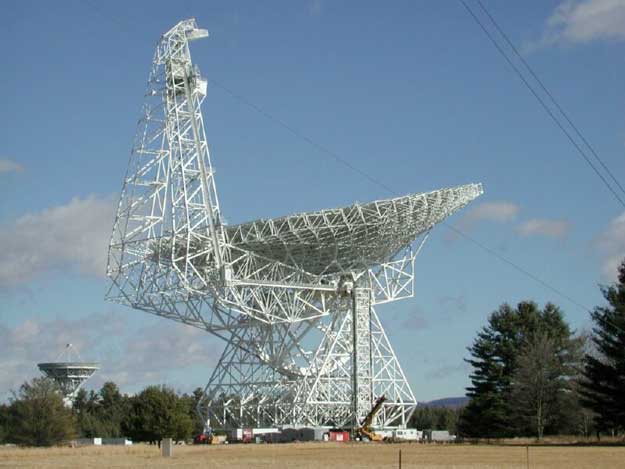Cosmology :Lecture 16
Cosmology
Cosmolgy is the study of the Universe as a whole and everything in it!
Rather an extensive definition. Commonly this really means the study
of the large scale structure of the universe. That is the big
picture. The building blocks of the Universe as best though of as galaxies.
So we shall being with a discusion of these.
Galaxies
Stars are not randomly of evenly spread through the Universe. Instead
they are clustered in Galaxies. With modern telescopes millions of
galaxies can be seen. Most are objects with a very small angular size
indicating their extreme distance from us. Some however are rather
large - the Andromeda galaxy has a huge size - 4 times that of the
moon, however it is rather a faint object which only takes on its true
appearance using a very large telescope and/or a large time exposure.
All galaxies are made up of a very large number of stars however they come in a variety of sizes and shapes. A classification system splits these into four categories. This, the hubble classification scheme, gives four classes
- Spiral Galaxy
- barred spiral galaxies
- elliptical
- irregular
This original scheme does have some problems - sometimes it can be difficult to
distinguish between spiral and barred spiral. Some facts regarding the types are
|
|
Spiral and Barred Spiral |
Elliptical |
irregular |
| percentage |
77% |
20% |
3% |
| mass (solar masses) |
109 to 4x10 11 |
105 to 10 13 |
108 to 3x10 10 |
| dimeter (kilo-parsecs) |
5 to 250 |
1 to 200 |
1 to 10 |
Some pictures of Galaxies colliding
Our Galaxy
Clusters of Galaxies
Some images of clusters
- A small cluster containing four
galaxies three spirals and one elliptic. The largest of the four is
the spiral at the bottom of the image - viewed end on. The two bright
spots are stars in the foreground.
- The Abell 2218 galaxy cluster
- The virgo cluster is a very large cluster of galaxies. This image is just of the centre.
Hubble's Law
Edwin Hubble was one of the pioneers of Cosmology. He was the
astronomer who proved the galaxies were actually very distant (and
hence very large!) objects outside our own galaxy. He then made
studies of galaxies and came to two conclusions
1) Firstly, the light from galaxies is often colour-shifted. Some
galaxies are blue-shifted but most are red shifted. This
colour-shifting, Hubble interpreted as meaning that the galaxies are
actualy moving away from us at high speeds.
2) The amount of red-shift or rate or recession is proportional to the distance the galaxy is from us. This is known as Hubble's law. In equation form
v = H0 d
where v is the velocity of recession and d is the distance from us.
The H0 is a constant which is know as Hubble's constant.
Hubble's observations remain one of the key fact regarding the
Universe however they are not completely clear cut. The data is
actually rather poor. This is illustrated by the difficulty in
measuring Hubble's constant accurately. Hubble gave a value
H0 = 500 km/s/Mpc
However the modern value is radically different from this - is has
changed during my scientific career. There is still much debate
but the best current value is
H0 = 75 km/s/Mpc
Despite the poor data we must still regard hubble's law as a FACT
about the Universe. As we shall see it can be INTERPRETED as
indicating an expanding Universe.
We shall now return to ``chew-over'' Hubble's law before advancing to its interpretation.
Distances and Standard Candles
One of the most difficult problems in Cosmology is in determining the
distance of objects which are (very) far away. For nearbye stars the
method of parallax can determine the distance, however for objects at
Cosmological distance the parallax effect is just too small.
One of the most useful methods of determining distance is to use a
standard candle . A Standard candle is an object for which we
know, with certainty, its absolute magnitude. Recall that an objects
absolute magnitude, apparant magnitude and distance are all
related. For stars we used the apparant magnitude and distance to
determine the absolute magnitude. In this case we use the apparant
magnitude and adsolute magnitude to determine distance.
| Absolute Magnitude | Distance (parsecs) |
Apparant Magnitude
|
| 0.0 | 10 | 0.0 |
| 0.0 | 100 | +5.0 |
| 0.0 | 1000 | +10.0 |
| 0.0 | 10,000 | +15.0 |
| 0.0 | 100,000 | +20.0 |
| 0.0 | 1,000,000=1Mpar | +25.0 |
For example, if we KNOW an object has absolute magnitude 0.0 and we
OBSERVE it to have an apparant magnitude of +20 then it must be
100,000 parsecs distant.
Examples of standard candles include
- Main Sequence Stars
- Cephid variable stars (giant regularly pulsating stars)
- Type-1a Supernova
- `largest galaxies`
© Dave Dunbar 2020





